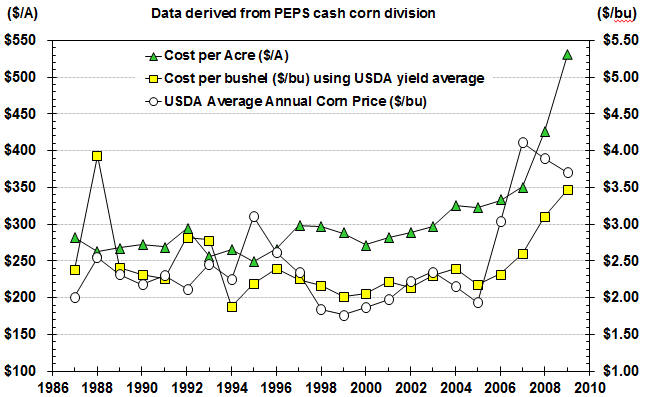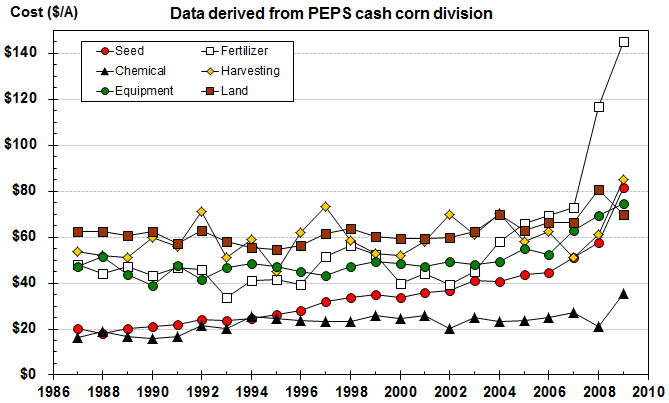September 14, 2010
Field Crops 28.63 - 81
Increasing Corn Production Costs
Cut Into Profits
Joe Lauer, Corn Agronomist
PDF version
As harvest draws near, growers are encouraged by record projected yields and
the strong corn prices available right now. But, a strong corn price does
not guarantee profitability unless production costs are under control. Even
though prices are strong, grower return (profitability) for 2010 is likely
going to be similar to previous years because of increasing productions
costs and a strong basis.
Figure 1 describes the average cost per bushel and cost per acre of
participants in the Cash Corn division of the PEPS program (Profits through
Efficient Production Systems). For more information regarding the PEPS
program see the website at
http://corn.agronomy.wisc.edu/PEPS. Production costs between high and low
yielding fields do not change dramatically. There is approximately $13-$24 per acre
difference between
high and low producing fields (Lauer, 2002). Since 2003, production costs have been steadily
increasing from approximately $2.30 per bushel and $300 per acre to $3.47 per bushel
and $531 per acre in 2009.
Figure 1. Average production costs for corn grown in Wisconsin. The
cost per bushel is calculated using the PEPS cost per acre and dividing by
the USDA average grain yield for Wisconsin. The USDA average annual corn
price is included for comparison.

With the exception of chemical costs, nearly all production cost categories
(seed, fertilizer, harvesting, equipment and land) have increased since 2003
(Figure 2). The most dramatic increases have been with seed and fertilizer.
Both productions costs were similar in 2003 (approximately $40-$42) with
seed doubling and fertilizer tripling by 2009. Harvesting costs include
grain drying, which varies by year and is usually expensive in cool years
like 2009.
Table 2. Average corn production costs in Wisconsin.

Although the PEPS program does not capture all of the production costs
associated with raising corn, it does give some feel for the kind of
production costs we are dealing with. PEPS costs include actual figures provided by contestants
in the program. These costs do
not include all costs of production. For example, overhead or miscellaneous
costs associated with operating a farm (i.e. field tiling, outfitting a
shop, plowing snow, maintaining fences, taxes, desktop work related to
management, etc.), are difficult to determine among farms, and is not
accounted for in the PEPS program. Typical overhead rates range from 18-46%
of production costs.
"Best of the Best" aptly describes the farmers participating in the PEPS
program.
Results reflect the efforts and costs of some of the best farmers growing
corn on the best land available using their best management practices. Lower
yielding fields are often not entered into the contest. Thus, "real world"
costs are probably higher for most farmers and that is why Wisconsin USDA
yield averages were used for calculating cost per bushel in this article.
Literature Cited
Lauer, J. 2002. Practices Used By Wisconsin Top-Profit
Corn and Soybean Farmers. Field Crops 28.6-34
PDF